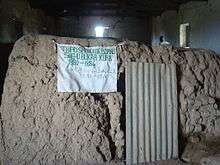Bukar Kura of Borno
Bukar or Bukar Kura bin Umar al-Kanemi (c. 1830-c. 1884 or 1885) was Shehu of Borno from 1881 to c. 1884.
| Bukar or Bukar Kura | |
|---|---|
| Reign | December 1881 – November 1884 to February or March 1885 |
| Predecessor | Umar I ibn Muhammad al-Amin |
| Successor | Ibrahim Kura |
| Born | c. 1830 |
| Died | November 1884 to February or March 1885[1] Borno |
| Burial | |
| Dynasty | Kanemi |
| Father | Umar I ibn Muhammad al-Amin |
| Religion | Muslim |
Reign of Bukar
Bukar became Shehu of Borno in 1881 at the death of his father Umar I ibn Muhammad al-Amin. His three-year reign was marked by a deep economic crisis which forced him to impose a tax on his subjects. In Kanuri language, this tax was called kumoreji (splitting a calabash in half) which meant that Bukar appropriated half the wealth of his subjects.[2][3]
Bukar as seen by Heinrich Barth
In 1851, a British expedition led by Heinrich Barth arrived in Borno. Barth met Bukar when he was around twelve and according to him he was:
the eldest son of Omar who now unfortunately seems to have the best claim to the succession, he was a child devoid of intelligence, or noble feelings

Dynasty
Bukar Kura of Borno House of Kanemi | ||
| Regnal titles | ||
|---|---|---|
| Preceded by Umar of Borno |
4th Shehu of Borno 1881-1884 |
Succeeded by Ibrahim Kura |
Footnotes
- Lavers, John, "The Al- Kanimiyyin Shehus: a Working Chronology" in Berichte des Sonderforschungsbereichs, 268, Bd. 2, Frankfurt a. M. 1993: 179-186.
- Louis Brenner, The Shehus of Kukawa: A History of the Al-Kanemi Dynasty of Bornu, Oxford Studies in African Affairs (Oxford, Clarendon Press, 1973), pp.86-88.
- Herbert Richmond Palmer, The Bornu Sahara and Sudan (London: John Murray, 1936), p. 269.
- Heinrich Barth,Travels and Discoveries in North and Central Africa (London: Longman, 1857), p.83.
Bibliography
- Barth, Heinrich, Travels and Discoveries in North and Central Africa (London: Longman, 1857).
- Brenner, Louis, The Shehus of Kukawa: A History of the Al-Kanemi Dynasty of Bornu, Oxford Studies in African Affairs (Oxford, Clarendon Press, 1973).
- Cohen, Ronald, The Kanuri of Bornu, Case Studies in Cultural Anthropology (New York: Holt, 1967).
- Isichei, Elizabeth, A History of African Societies to 1870 (Cambridge: Cambridge University Press, 1997), pp. 318–320, ISBN 0-521-45599-5.
- Lange, Dierk, 'The kingdoms and peoples of Chad', in General history of Africa, ed. by Djibril Tamsir Niane, IV (London: Unesco, Heinemann, 1984), pp. 238–265.
- Last, Murray, ‘Le Califat De Sokoto Et Borno’, in Histoire Generale De l'Afrique, Rev. ed. (Paris: Presence Africaine, 1986), pp. 599–646.
- Lavers, John, "The Al- Kanimiyyin Shehus: a Working Chronology" in Berichte des Sonderforschungsbereichs, 268, Bd. 2, Frankfurt a. M. 1993: 179-186.
- Nachtigal, Gustav, Sahara und Sudan : Ergebnisse Sechsjähriger Reisen in Afrika (Berlin: Weidmann, 1879).
- Oliver, Roland & Anthony Atmore (2005). Africa Since 1800, Fifth Edition. Cambridge: Cambridge University Press. ISBN 0-521-83615-8.
- Palmer, Herbert Richmond, The Bornu Sahara and Sudan (London: John Murray, 1936).
- Taher, Mohamed (1997). Encyclopedic Survey of Islamic Dynasties A Continuing Series. New Delhi: Anmol Publications PVT. LTD. ISBN 81-261-0403-1.
This article is issued from Wikipedia. The text is licensed under Creative Commons - Attribution - Sharealike. Additional terms may apply for the media files.